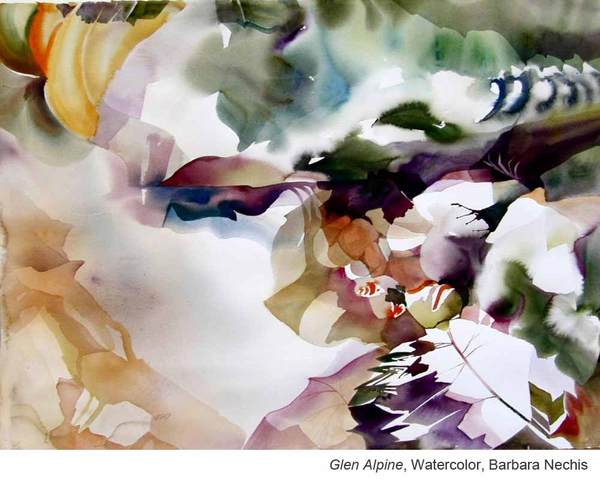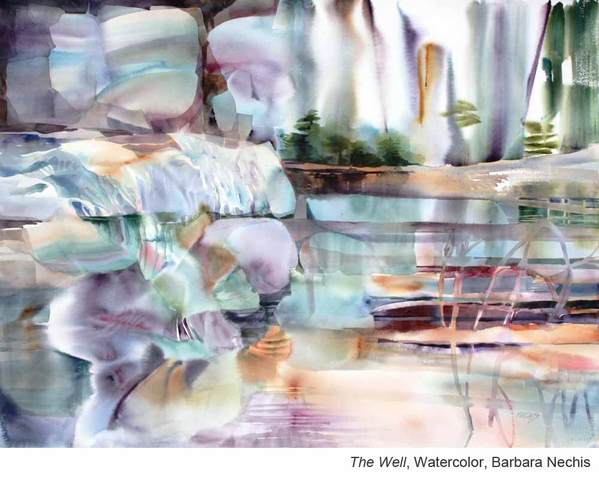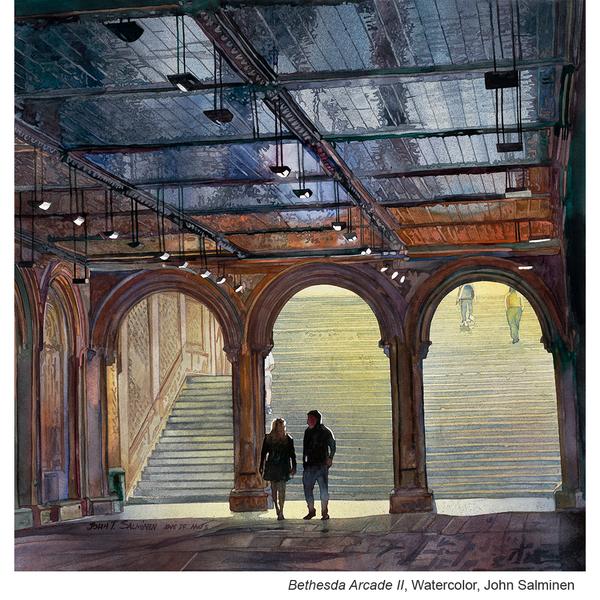“Unlike many other mediums, watercolor does some of the work for you,” says Barbara Nechis. “It can give you unexpected effects that can’t be repeated, so that each painting becomes unique. When it’s done well and water used properly, watercolor can create an illusion that the paint arrived magically.

Finding Inspiration
“I don’t think about making a painting when I’m observing shapes in nature. When driving or walking I’m absorbing what I see. I photograph a great deal but I never use these photos. I think the process of framing an image helps to imprint the essence of it in my brain, although not the specifics. When I begin a painting I don’t have an image of what it will be. I am not transferring thoughts to paper. My objective is to allow my feelings about a subject to come out naturally, then guide them into shapes and value patterns. Although the feeling of rock, trees, mountains, flowers or water is there because I have used their basic shapes, I haven’t actually painted these objects. Each painting is new and by allowing the water and paint to flow, letting the paper itself suggest the subject matter and the technique as well, ideas begin to arise. I invent images as I go along. I try to convey the essence of a subject not just describe its visual facts. I am watching each stroke as I put it down, adjusting it to fit with the previous stroke.”

The Artist’s Process
“I start with no vision at all. I begin without a specific image in mind and work through as one would work out a doodle which is never planned and where one thing leads to another. Sometimes I wet the whole paper and execute a wet-into-wet underpainting which will give subsequent layers depth and color variations. When I work on large paper I usually begin by making a large shape with as much water as the paper will hold, extending it to at least one edge of the paper. Then I pour off the excess water, add paint, dry it and then repeat with subsequent shapes layering over each other to create complex compositions. I’m drawn to shapes in nature.”

STRIKING AN EMOTIONAL CHORD
“When I’m on the street with my camera looking for potential subjects, I’m most concerned with the composition of the scene and the light quality,” says John Salminen. “The composition gives structure and can lead the viewer into and through the scene. The light quality imparts mood and atmosphere. If I can successfully incorporate those things, the audience will invent the story, and it will be, in part, their story. I don’t attempt to tell stories, but rather, I try to elicit a response. It is very gratifying create a watercolor painting that strikes an emotional chord and momentarily bonds me to the viewer.

Using Light and Shadow
“I establish glow in my watercolors by gradually shifting the value in the area from light to dark. As the lightest values subtly shift to increasingly darker values luminosity is created. This can be enhanced by temperature shifts as well but color and temperature alone do not create a luminous glow. Even black and white value studies can ‘glow.’

“We perceive our world through our awareness of the subtleties of light and shadow. As artists, we recreate those subtle relationships with value. I believe I still have a lot to learn about value and this is one of the challenges that keeps me excited about the medium of watercolor.”
Barbara and John answer your watercolor questions in an interactive roundtable discussion — A Watercolor Artist’s Guide to Confidence, Success and Artistic Growth — on Thursday, December 7 @ 3pm ET. Discover how to find your “signature style,” and gain important insights into growing your art career.








Very helpful . I have been asked to teach a fundamentals class and I was looking for just the right way to introduce our wonderful medium
I feel like I will never be able to appreciate watercolors as much as I want to. I think maybe I have a hard time with WHAT I want to paint, then executing it is even harder for me. The details in the last 2 paintings in this article leave me in awe. The first 2 are wonderful in that the details are left out and are left up to the viewer to fill in (my take anyway). All are beautiful. Maybe I need to quit trying so hard and just let it flow…